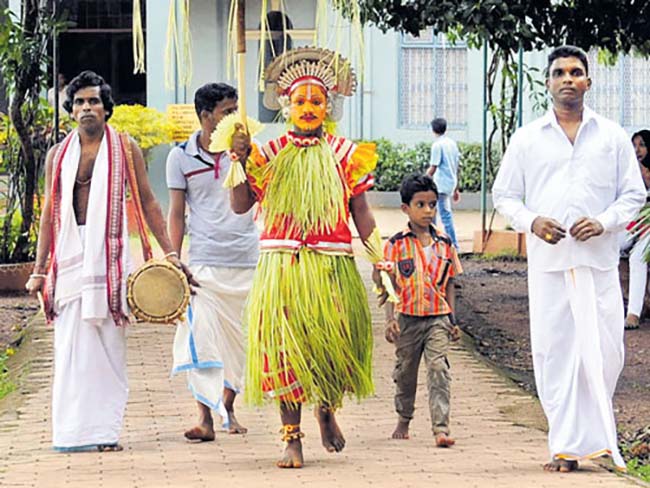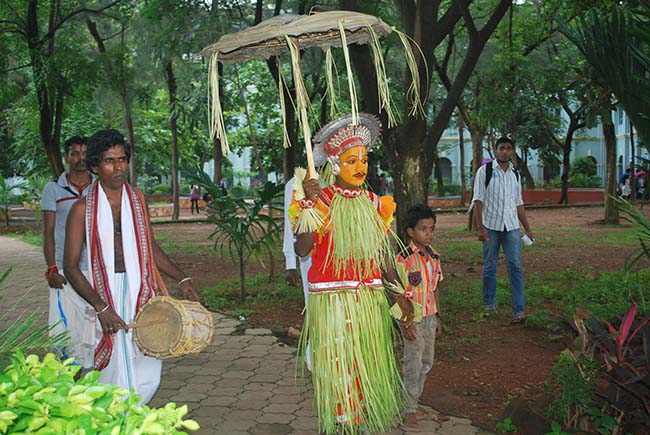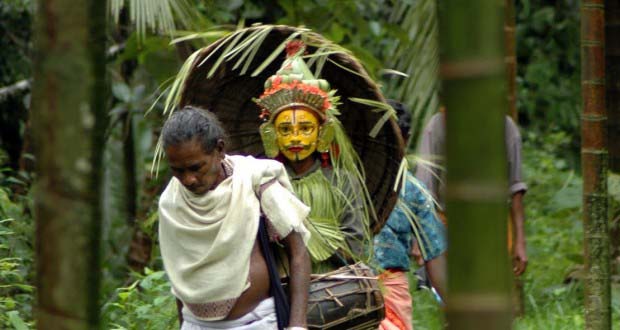
“Aati” is a Tulu month in the order of Tulu calendar of months like January, February, March, and the like.
The month of Aati is special in many ways. It normally comes in the months of July and August. It is a time for farmers to take rest after sowing paddy in the field. However, rain does not take a break during this time. Mother Nature is seen at its greenest in the season.
For many, especially Hindus, in Tulu Nadu, “Aati” now is a forbidden month. Hence no marriages, house warming ceremonies, festivals in temples, purchasing of property or vehicles, no purchase of gold, and any auspicious functions. Not many Christians and Muslims considered “Aati” inauspicious.
According to some experts on folklore studies taboos associated with this month should be viewed from the historic perspective especially relating to agriculture. As usually, there was heavy rain during “Aati” and there were no crops, food grains, and vegetables. Hence agriculture families were economically not sound and it was considered as a month of poverty. It was also a month of diseases and a month of remembering deceased members of the family by offering food to their spirits. “It was to establish relationship between generations,” he said.
As there was poverty and diseases, people kept away celebrations during this period, it is said. It was also said that people used to eat ethnic food having medicinal properties. The people from Nalike community (Particular community) who were considered traditional folk healers donned the role of “Aati kalenja” and used to visit houses dancing and begging for alms such as paddy or whatever food grains stored in houses. The “Aati kalenja” was considered as eradicator of evils in society.

Some intellectuals said that the concept of begging could not be accepted now and the relevance of “Aati kalenja” as the eradicator of evils appeared obsolete now as many diseases have come under control with better access to medical facilities.
Some experts on Folklore studies interpret “Aati” was inauspicious was a “belief”. The beliefs associated with “Aati” could be traced to dominant agrarian society which existed in Tulu Nadu.
According to some experts on folklore studies some of the beliefs associated with “Aati” had changed now. For example, earlier homemakers (married women) were being sent to their respective mothers’ homes for one month for taking rest.

The objective behind this was that a married woman who used to work throughout in her husband’s home doing both household and agriculture needed rest. Now this practice had become outdated. Likewise, food habits of people had changed and some of the beliefs were difficult to change. “Society lives on beliefs,” it is said.
Some Rationalists argue that the belief that the “Aati” was inauspicious was nothing but a superstition and there was no basis in having such beliefs. People who purchased something like house, car or moved to new house during this “Aati” month did not face any problem.

Aati festival
Aati Kalenja is a fast disappearing Tulunadu tradition. It is believed in Tulunadu that the spirit Kalenja comes down to Parashurama Kshetra during the month of Aati (July-Aug : rainy season) to protect people from diseases, as insects and bacteria are bound to be more during this time. A certain section of people belonging to the Nalike tribe dress up as Kalenje, invoke the spirit and go around villages assuring people of good health and in turn collecting some rice, coconut etc. It is an amazing tradition, just like the Bhuta Kola, Yakshagana and other Tulunadu traditions.
Aatikalañja is a ritualistic folk dance performed by the Nalke community. Kalañja is the name of a minor spirit who is in charge of the protection of the village folk during the month of July – August rainy season. And that was Aati (Tulu for the month of Aashadha), wherein, according to the Hindu almanac, nature was at her vicious best. Aati commences invariably from July and runs up to mid of August. It is during this month that our entire district witnesses heavy downpour that replenishes Nature and activates her for another cycle.
It is true that the rains beautify Nature and nourish all living organisms. But there is a price to be paid for this – the inundation of land by swelling rivers and streams; the landslides and avalanches; the purifying organic matter and stagnant water in pools and ponds that become havens for parasites and harmful insects to breed in; the sudden bolt from the blue that strikes with destructive intensity. All these leaving Nature’s magnificent creation – Man himself – in the cold.
So what would man do in such circumstances? Naturally, he would frame it as a zero month. But, this was not the only thing he did. Instead, he devised new methods either to please the nature or to chase the evil that had cast its ugly shadows on his creed; thereby satisfying his urge for supremacy
Thus was born Aati Kalanja, on such creation of our ancestors to keep away the dangers wrought by the evil forces. It is widely believed that by practicing this ritual which is in the form of a dance, one would in fact exorcise the evil spirits that shroud the house.
During this period the members of the Nalke community decorate their body with the constume made of tender coconut leaves, ankelets, colourful cloth, long cap made of areca nut sheaths (Paale in tulu) etc., paint their face with various colours and designs, hold an umbrella made of leaves and decorated with flowers, go from house to house and dance in front of the spirit and beat a small drum known as tembare.
According to the ancient folklore, one can observe that there are two types of folk medicinal sciences. The first one is the natural form of folk medicine which involves diagnosis and treatment of physical ailments. Whereas the latter is the religious form, which revolves around sorcery and black magic – often used as a remedy for mental and psychological affliction. Aati Kalanja falls in this category.
According to legend, the origin of this art-form is connected to a mythological character called “Kalanja”. He was no ordinary man, being bestowed with divine powers. He was also destined to vanquish the all-pervading evil during the month of Aati.
So even to this day the same act is performed by the people who masquerade themselves as Kalanja and dance to the beats of drums in a rather unique fashion. It is said that by performing the dance of Kalanja, the performer’s house is freed from the evil spirits and restored to normalcy.
The Kalanja, who visits the homes during every monsoon, might look preposterous to viewers owing to his attire and facial make-up. Sporting a red tooth-brush moustache with a face smudged with shades of black and grey, he would surely not be a pleasant sight. The house-holder gives them paddy, rice, coconut, turmeric, charcoal and the dancers perform certain rituals to ward off diseases and other misfortunes of the family and the cattle.
But the skirt that flows down his waist is undoubtedly a piece of art. It is made of tender leaves of coconut palm which are interlaced with the strands made out of sheaths of the banana plant, which makes it a perfectly designed natural outfit for that particular season. His ornaments are also made of palm leaves and he wears a headgear resembling a cobra.
Shekar Moily



Comments are closed.